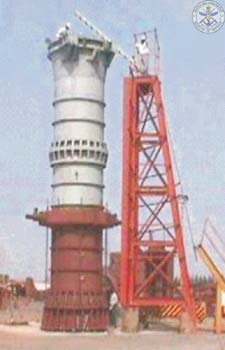I am going to selectively use your picture. This is probably not the right configuration. All three missiles are not launched simultaneously. There will be 4 launch tubes. Each launch tube will launch just one at a time. So up to four missiles from four different tubes. Your design seems to imply three missiles from one launch tube. It's not how everyone else does it.
Please use your third or fourth figure to see how big the diameter is. Your circle is of the longitudinal cross section of the missile cap and not the missile diameter. You can see the missile diameter in reference to the sensors in the third or fourth picture(Middle row). The one where the missile is almost near the top of the hatch.
An additional reason why your figures with three in the same tube is not accurate is the international standards of 2 to 2.2 meters for SLBMs with MIRV elsewhere. The launch tested a 1500km or so SLBM. We need the bigger plantoon to test the 13 meter 2.2 m dia SLBMS. Also the missile leaves the hatch almost dead center. So no space of the rest of the three tubes within the hatch.
The additional engineering consideration which makes your design difficult is that once a launch is conducted water pours into the tube. You won't expose all missiles to water by opening the hatch. once the misslie is launched the water in the tube needs to be emptied and the second canister moved into place. So yes it could be 3 or 4 missiles in one of these tubes. With four such tubes. The video has a second official picture which I posted earlier from which I derived the 4 x 4 configuration. It could be 3 x 4 as well. You can have a look at minute 3.53 of the official video.
So the 3D figure is off in my view and isn't the right configuration for the final Agni VI SLBM version of 2 to 2.2 meters dia and 13 meter length. This has been confirmed as the final configuration by AC.
Consider this the hatch has a diameter of 3m. The area of the circle is 7.06 sq m.
The missile according to my calculation has a diameter of 1.5 to 1.8m. The cross section area of the missile as opposed to cap you drew a circle around is 2.54 sq m to 1.76 sq m. Consistant with the smaller foot print of the B05 test on January 27th 2013. It wasn't a really big missile. So yes the missile will "appear" much much smaller than the 3m hatch. The area of a circle increases in terms of square of the radius and consequently diameter. I hope this makes sense.
Even for the final configuration the missile cross section for 2.2 meters will be 3.8 sq m vs the hatch area of 7.06 sq m. You need this to allow for down bubble launches. Down bubble as in launch from other than the submarine in vertical steady state aligned with the sea surface or plumb-line. There also needs to be clearance for launching as well so yes the hatch door.
Your three missile config will require 7.62 sq m if the missile is 1.8 m which is bigger than the available 7.06 sq m area and 5.28 sq m at the lower end 1.5 m missile dia which will make it a tight fit and not enough clearence

Our missiles need to grow fatter to 2.2 to get to eventual configuration of SLBMs around the world. So not really the right design

Good effort though.
As always feel feel to knock me around in arithmetic. That isn't my strong suit. I am pretty confident with the rest of the analysis. 3 to 3.5 m hatch with one missile of 1.5 to 1.8m (as tested on 27th jan 2013). The future missiles are 2.2 meters and 10m long and 13 m long "eventually". Only one missile at a time in the launch tube

The design is simpler that way. (The other figure just gives you an idea of how many missiles will be carried and not how many will launch at the same time. You can always rotate missiles into place under the hatch instead of engineering a bigger hatch which requires you to take in more water and dead weight with each launch.)

























